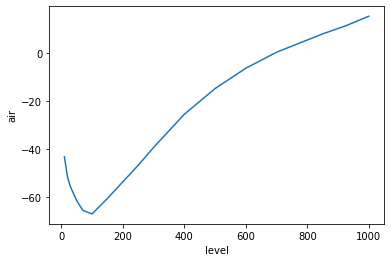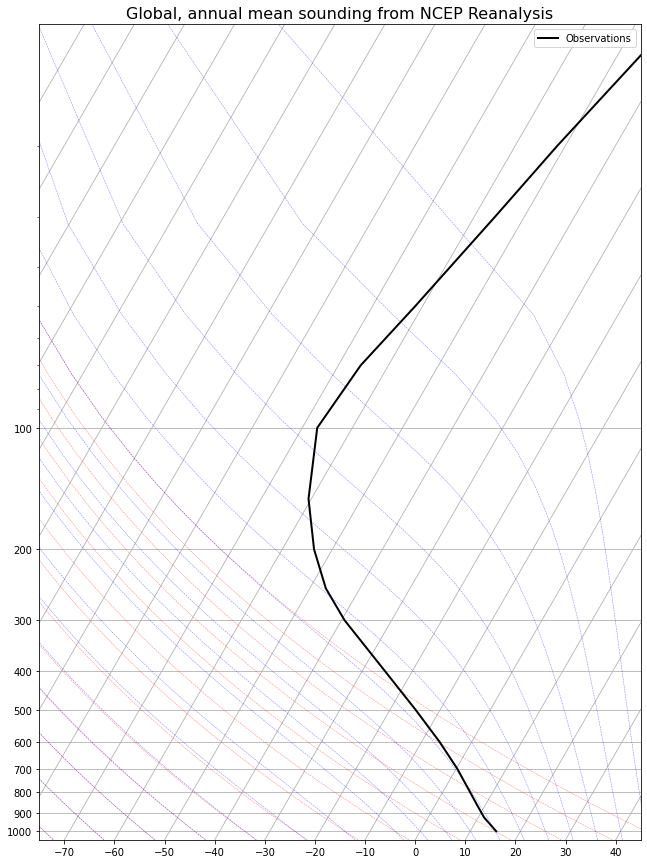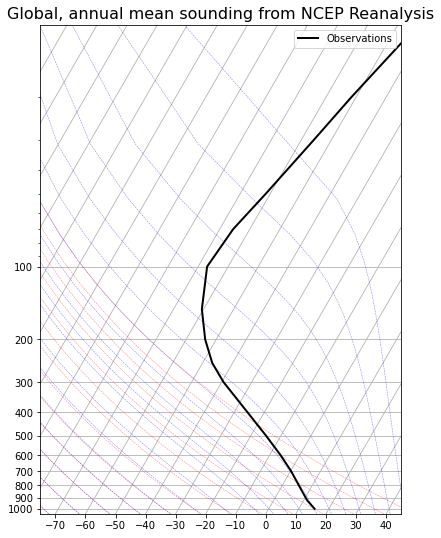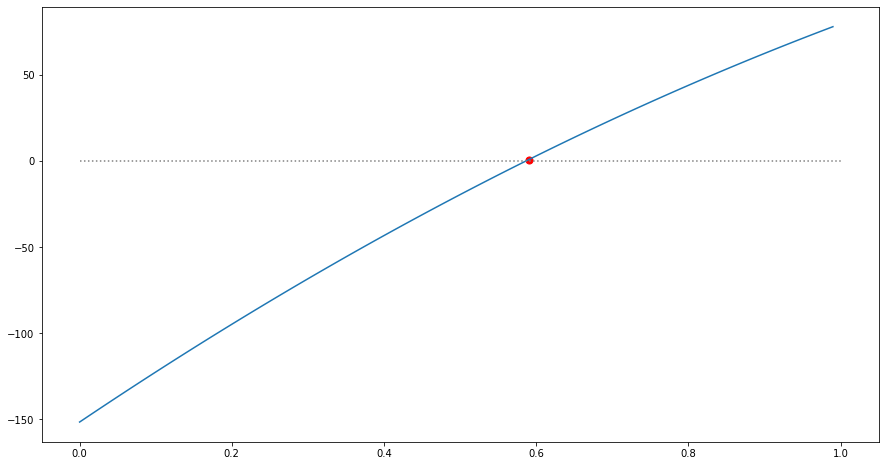Greenhouse model
Greenhouse model#
Task 1: Plug Eq. (7) into Eq. (6) and solve for the radiative equilibrium suface temperature \(T_e\)
# Solve for the radiative equilibrium temperature
sigma = 5.67e-8 # W m^-2 K^-4
Q = 342 # Incoming shortwave radiation W m^-2
albedo = 0.3 # Albedo
Te = (((1-0.3)*342)/5.67e-8)**(1/4)
print('Radiative equilibrium temperature: {:.2f}'.format(Te))
Radiative equilibrium temperature: 254.91
Task 2: Where in the atmosphere do we find \(T_e\)?
from IPython.display import display, Markdown, Latex, Math
import numpy as np
import matplotlib.pyplot as plt
import xarray as xr
## The NOAA ESRL server is shutdown! January 2019
ncep = xr.open_dataset('./files/air.mon.ltm.1981-2010.nc',use_cftime=True)
ncep
<xarray.Dataset>
Dimensions: (level: 17, lat: 73, lon: 144, time: 12, nbnds: 2)
Coordinates:
* level (level) float32 1e+03 925.0 850.0 ... 30.0 20.0 10.0
* lat (lat) float32 90.0 87.5 85.0 82.5 ... -85.0 -87.5 -90.0
* lon (lon) float32 0.0 2.5 5.0 7.5 ... 352.5 355.0 357.5
* time (time) object 0001-01-01 00:00:00 ... 0001-12-01 00:0...
Dimensions without coordinates: nbnds
Data variables:
climatology_bounds (time, nbnds) object 1981-01-01 00:00:00 ... 2010-12-...
air (time, level, lat, lon) float32 ...
valid_yr_count (time, level, lat, lon) float32 ...
Attributes:
description: Data from NCEP initialized reanalysis (4...
platform: Model
Conventions: COARDS
not_missing_threshold_percent: minimum 3% values input to have non-missi...
history: Created 2011/07/12 by doMonthLTM\nConvert...
title: monthly ltm air from the NCEP Reanalysis
dataset_title: NCEP-NCAR Reanalysis 1
References: http://www.psl.noaa.gov/data/gridded/data...# calculate the area-weighted temperature over its domain. This dataset has a regular latitude/ longitude grid,
# thus the grid cell area decreases towards the pole. For this grid we can use the cosine of the latitude as proxy
# for the grid cell area.
weights = np.cos(np.deg2rad(ncep.lat))
# Use the xarray function to weight the air temperature array
air_weighted = ncep.air.weighted(weights)
# Take the mean over lat/lon/time to get a mean vertical profile
weighted_mean = air_weighted.mean(("lat","lon", "time"))
# a "quick and dirty" visualization of the data
weighted_mean.plot()
[<matplotlib.lines.Line2D at 0x13ad4dab0>]

# Import the metpy library
from metpy.plots import SkewT
fig = plt.figure(figsize=(15, 15))
# Create the skew-plot with the metpy module (see manual for details)
skew = SkewT(fig, rotation=30)
skew.plot(weighted_mean.level, weighted_mean, color='black', linestyle='-', linewidth=2, label='Observations')
# Scale the x and y axis
skew.ax.set_ylim(1050, 10)
skew.ax.set_xlim(-75, 45)
# Add the adiabats to the plot
skew.plot_dry_adiabats(linewidth=0.5)
skew.plot_moist_adiabats(linewidth=0.5)
# Adde axis labels and legend
skew.ax.legend()
skew.ax.set_title('Global, annual mean sounding from NCEP Reanalysis',
fontsize = 16)
Text(0.5, 1.0, 'Global, annual mean sounding from NCEP Reanalysis')

Task 3: What is the surface temperature with the single layer model?
# Solve for the atmospheric surface temperature
# Calc surface temperature
Ts = 2**(1/4) * Te
print('Surface temperature: {:.2f}'.format(Ts))
Surface temperature: 303.14
Why does the model overestimate the surface temperature?
Task 5: Write a Python function for \(OLR = U_2 = (1-\epsilon)^2 \sigma T_s^4 + \epsilon(1-\epsilon)\sigma T_0^4 + \epsilon \sigma T_1^4\)
# The function calculates the OLR of the two-layer model
def two_layer_model(Ts, T0, T1, epsilon):
return ((1-epsilon)**2)*sigma*Ts**4 + epsilon*(1-epsilon)*sigma*T0**4 + epsilon*sigma*T1**4
Task 6: We will tune our model so that it reproduces the observed global mean OLR given observed global mean temperatures. Determine the temperatures for the two-layer model from the following sounding

Task 8: Find graphically the best fit value of \(\epsilon\)
import numpy as np
import matplotlib.pyplot as plt
# Assignments
OLR = [] # initialize array
epsilons = [] # initialize array
OLR_obs = 238.5 # observed outgoing long-wave radiation
def find_nearest(array, value):
"""
Auxiliary function to find index of closest value in an array
array :: input array
value :: the value to find in the array
"""
# This searches the minimum between the values and all values in an array
# Basically, we enumerate over the array. The enumerator iterates over the array and returns a
# tuple (index, value) for each element. We take the value (x[1]) from this tuple and substract the value
# we are searching for. The element which has the smallest difference is what we are looking for. We finally
# return the index of this value.
idx,val = min(enumerate(array), key=lambda x: abs(x[1]-value))
return idx
# Optimize epsilon
# We define a range from 0 to 1 with a 0.01 step and calculate the OLR for each of these epsilon values
for eps in np.arange(0, 1, 0.01):
OLR.append(OLR_obs - two_layer_model(288, 275, 230, eps))
# Store the results in the epsilon-array
epsilons.append(eps)
# Now, find the closest value to the observed OLR using the previously defined function
idx = find_nearest(OLR, 0)
# Save the optimized epsilon in the epsilons-array
epsilon = epsilons[idx]
# Plot the results
print('The optimized transmissivity is: {:.2f}'.format(epsilons[idx]))
plt.figure(figsize=(15,8))
plt.plot(epsilons,OLR);
plt.scatter(epsilons[idx], OLR[idx], s=50, color='r')
plt.hlines(0,0,1,linestyles='dotted',color='gray');
The optimized transmissivity is: 0.59

# Validate the result
print('The modelled OLR is {:.2f}, while the observed value is 238.5'.format(two_layer_model(288, 275, 230, epsilon)))
The modelled OLR is 237.63, while the observed value is 238.5
Task 9: Write a Python function to calculate each term in the OLR. Plug-in the observed temperatures and the tuned value for epsilon.
def two_layer_terms(Ts, T0, T1, epsilon):
"""
This is the same as the two-layer model but instead of returning the OLR this function return the
individual terms of the two-layer equation
"""
return ( ((1-epsilon)**2)*sigma*Ts**4, epsilon*(1-epsilon)*sigma*T0**4, epsilon*sigma*T1**4)
# Calculates the individual terms
term1, term2, term3 = two_layer_terms(288, 275, 230, epsilon)
display(Markdown(r"""> **Term 1:** ${:.2f} ~ Wm^2$ <br> **Term 2:** ${:.2f} ~ Wm^2$ <br> **Term 3:** ${:.2f} ~ Wm^2$""".format(term1, term2, term3)))
display(Markdown(r"""> **Total** (sum of all terms): ${:.2f} ~ Wm^2$""".format(term1+term2+term3)))
Term 1: $65.57 ~ Wm^2$
Term 2: $78.44 ~ Wm^2$
Term 3: $93.62 ~ Wm^2$
Total (sum of all terms): $237.63 ~ Wm^2$
Task 10: Changing the level of emission by adding absorbers, e.g. by 10 %. Suppose further that this increase happens abruptly so that there is no time for the temperatures to respond to this change. We hold the temperatures fixed in the column and ask how the radiative fluxes change.
Which terms in the OLR go up and which go down?
# Calculates the individual terms
term1, term2, term3 = two_layer_terms(288, 275, 230, epsilon+0.1)
display(Markdown(r"""> **Term 1:** ${:.2f} ~ Wm^2$ <br> **Term 2:** ${:.2f} ~ Wm^2$ <br> **Term 3:** ${:.2f} ~ Wm^2$""".format(term1, term2, term3)))
display(Markdown(r"""> **Total** (sum of all terms): ${:.2f} ~ Wm^2$""".format(term1+term2+term3)))
Term 1: $37.49 ~ Wm^2$
Term 2: $69.36 ~ Wm^2$
Term 3: $109.48 ~ Wm^2$
Total (sum of all terms): $216.33 ~ Wm^2$
Task 11: Calculate the radiative forcing for the previous simulation
# First calculate the unperturbed terms
term1, term2, term3 = two_layer_terms(288, 275, 230, epsilon)
# Now, add the perturbation to the epsilon values
term1p, term2p, term3p = two_layer_terms(288, 275, 230, epsilon+0.1)
# Print the results
display(Markdown(r"""> **RS**: ${:.2f} ~ Wm^2$ <br>
**R0**: ${:.2f} ~ Wm^2$ <br>
**R1**: ${:.2f} ~ Wm^2$
""".format(-(term1p-term1),
-(term2p-term2),
-(term3p-term3))))
display(Markdown(r"""> **Radiative forcing**: ${:.2f} ~ Wm^2$""".format(-(term1p-term1)-(term2p-term2)-(term3p-term3))))
RS: $28.09 ~ Wm^2$
R0: $9.08 ~ Wm^2$
R1: $-15.87 ~ Wm^2$
Radiative forcing: $21.30 ~ Wm^2$
Task 12: What is the greenhouse effect for an isothermal atmosphere?
# First calculate the unperturbed terms
term1, term2, term3 = two_layer_terms(288, 288, 288, epsilon)
# Now, add the perturbation to the epsilon values
term1p, term2p, term3p = two_layer_terms(288, 288, 288, epsilon+0.1)
# Print the results
display(Markdown(r"""> **RS**: ${:.2f} ~ Wm^2$ <br>
**R0**: ${:.2f} ~ Wm^2$ <br>
**R1**: ${:.2f} ~ Wm^2$
""".format(-(term1p-term1),
-(term2p-term2),
-(term3p-term3))))
display(Markdown(r"""> **Radiative forcing**: ${:.2f} ~ Wm^2$""".format(-(term1p-term1)-(term2p-term2)-(term3p-term3))))
RS: $28.09 ~ Wm^2$
R0: $10.92 ~ Wm^2$
R1: $-39.01 ~ Wm^2$
Radiative forcing: $-0.00 ~ Wm^2$
Task 13: For a more realistic example of radiative forcing due to an increase in greenhouse absorbers, we use our observed temperatures and the tuned value for epsilon. Assume an increase of epsilon by 2 %.
# Perturb the epsilon values by 2 %
depsilon = epsilon * 0.02
print('The epsilon disturbance: {:.3f} \n'.format(depsilon))
term1, term2, term3 = two_layer_terms(288, 275, 230, epsilon)
term1p, term2p, term3p = two_layer_terms(288, 275, 230, epsilon+depsilon)
# Print the results
display(Markdown(r"""> **RS**: ${:.2f} ~ Wm^2$ <br>
**R0**: ${:.2f} ~ Wm^2$ <br>
**R1**: ${:.2f} ~ Wm^2$
""".format(-(term1p-term1),
-(term2p-term2),
-(term3p-term3))))
display(Markdown(r"""> **Radiative forcing**: ${:.2f} ~ Wm^2$""".format(-(term1p-term1)-(term2p-term2)-(term3p-term3))))
The epsilon disturbance: 0.012
RS: $3.72 ~ Wm^2$
R0: $0.73 ~ Wm^2$
R1: $-1.87 ~ Wm^2$
Radiative forcing: $2.58 ~ Wm^2$
import numpy as np
def warming_per_year(ASR=0.2):
'''ASR = absorbed shortwave radiation'''
# Surface of the earth
area_earth = 4*np.pi*6371000**2
# Pressure level
p = 5e4
# Total mass above 500 hPa [kg]
m_atmos = (area_earth*p)/9.81
# J
J_per_m2 = ASR*60*60*24
J = J_per_m2*area_earth
# J/kg
cp = 1004
# warming per day
warming = (J / m_atmos) / cp
#display(Markdown(r"""> Warming per year: ${:.2f} ~ K$ <br>
# """.format(warming*365)))
return warming*365
sigma = 5.67e-8
epsilon = 0.59
# The function calculates the OLR of the two-layer model
def two_layer_model_aerosols(Ts, T0, T1, epsilon, asr):
T1 = T1 + warming_per_year(asr)
T0 = T0 + + warming_per_year(asr/10)
return ((1-epsilon)**2)*sigma*Ts**4 + epsilon*(1-epsilon)*sigma*T0**4 + epsilon*sigma*T1**4
def two_layer_terms(Ts, T0, T1, epsilon, asr, lvl):
"""
This is the same as the two-layer model but instead of returning the OLR this function return the
individual terms of the two-layer equation
"""
if lvl == 1:
T1 = T1 + warming_per_year(asr)
elif lvl == 0:
T0 = T0 + warming_per_year(asr)
cp_soil = 1900
Ts = (((1-0.32)*(342-asr))/(0.59*sigma))**(1/4)
print(Ts,T0,T1)
return ( ((1-epsilon)**2)*sigma*Ts**4, epsilon*(1-epsilon)*sigma*T0**4, epsilon*sigma*T1**4)
from IPython.display import display, Markdown, Latex, Math
term1, term2, term3 = two_layer_terms(288, 275, 230, epsilon, asr=0.0, lvl=0)
term1p, term2p, term3p = two_layer_terms(288, 275, 230, epsilon+0.0, asr=3.0, lvl=0)
# Print the results
print('Term1 {:.2f} Term2 {:.2f} Term3: {:.2f}'.format(term1, term2, term3))
display(Markdown(r"""> **RS**: ${:.2f} ~ Wm^2$ <br>
**R0**: ${:.2f} ~ Wm^2$ <br>
**R1**: ${:.2f} ~ Wm^2$
""".format(-(term1p-term1),
-(term2p-term2),
-(term3p-term3))))
display(Markdown(r"""> **Radiative forcing**: ${:.2f} ~ Wm^2$""".format(-(term1p-term1)-(term2p-term2)-(term3p-term3))))
288.75199073610895 275.0 230
288.1166689759792 293.4881370517928 230
Term1 66.26 Term2 78.44 Term3: 93.62
RS: $0.58 ~ Wm^2$
R0: $-23.32 ~ Wm^2$
R1: $-0.00 ~ Wm^2$
Radiative forcing: $-22.74 ~ Wm^2$
from IPython.display import display, Markdown, Latex, Math
term1, term2, term3 = two_layer_terms(288, 275, 230, epsilon, asr=0.0, lvl=1)
term1p, term2p, term3p = two_layer_terms(288, 275, 230, epsilon+0.0, asr=1.0, lvl=1)
# Print the results
print('Term1 {:.2f} Term2 {:.2f} Term3: {:.2f}'.format(term1, term2, term3))
display(Markdown(r"""> **RS**: ${:.2f} ~ Wm^2$ <br>
**R0**: ${:.2f} ~ Wm^2$ <br>
**R1**: ${:.2f} ~ Wm^2$
""".format(-(term1p-term1),
-(term2p-term2),
-(term3p-term3))))
display(Markdown(r"""> **Radiative forcing**: ${:.2f} ~ Wm^2$""".format(-(term1p-term1)-(term2p-term2)-(term3p-term3))))
288.75199073610895 275 230.0
288.5406828809315 275 236.16271235059762
Term1 66.26 Term2 78.44 Term3: 93.62
RS: $0.19 ~ Wm^2$
R0: $-0.00 ~ Wm^2$
R1: $-10.44 ~ Wm^2$
Radiative forcing: $-10.25 ~ Wm^2$
(((1-0.32)*342)/(epsilon*sigma))**(1/4)
288.75199073610895
import numpy as np
area_earth = 4*np.pi*6371000**2
# Pressure level
p = 5e4
# Total mass above 500 hPa [kg]
m_atmos = (area_earth*p)/9.81
m_atmos
2.599716982210949e+18


